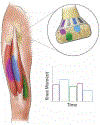Selective Nerve Cuff Stimulation Strategies for Prolonging Muscle Output
- PMID: 31449001
- PMCID: PMC7042042
- DOI: 10.1109/TBME.2019.2937061
Selective Nerve Cuff Stimulation Strategies for Prolonging Muscle Output
Abstract
Neural stimulation systems are often limited by rapid muscle fatigue. Selective nerve cuff electrodes can target independent yet synergistic motor unit pools (MUPs), which can be used in duty-cycle reducing stimulation paradigms to prolong joint moment output.
Objective: This study investigates waveform parameters within moment-prolonging paradigms and determines strategies for their optimal implementation.
Methods: Composite flat-interface nerve cuff electrodes (C-FINEs) were chronically implanted on feline proximal sciatic nerves. Cyclic stimulation tests determined effects of stimulation period and duty cycle in different MUP types. Ideal parameters were then used in duty-cycle reducing carousel stimulation. Time to 50% reduction in moment (T50), moment overshoot, and moment ripple were determined for constant, open-loop carousel, and moment feedback-controlled closed-loop carousel stimulation.
Results: A stimulation period of 1 s best maintained joint moment for all MUPs. Low (25%) duty cycles consistently improved joint moment maintenance, though allowable duty cycle varied among MUPs by gross muscle and fiber type. Both open- and closed-loop carousel stimulation significantly increased T50 over constant stimulation. Closed-loop carousel significantly decreased moment overshoot over the other conditions, and significantly decreased moment ripple compared with open-loop stimulation.
Conclusion: Selectivity-enabled carousel stimulation prolongs joint moment over conventional constant stimulation. Appropriate waveform parameters can be quickly determined for individual MUPs and stimulation can be controlled for additional performance improvements with this paradigm.
Significance: Providing prolonged, stable joint moment and muscle output to recipients of motor neuroprostheses will improve clinical outcomes, increase independence, and positively impact quality of life.
Figures












References
-
- McDonnell MK, Delitto A, Sinacore DR, and Rose SJ, “Electrically Elicited Fatigue Test of the Quadriceps Femoris Muscle,” Phys. Ther, vol. 67, no. 6, pp. 941–945, June 1987. - PubMed
-
- Sinacore DR, Jacobson RB, and Delitto A, “Quadriceps Femoris Muscle Resistance to Fatigue Using an Electrically Elicited Fatigue Test Following Intense Endurance Exercise Training,” Phys. Ther, vol. 74, no. 10, pp. 930–939, October 1994. - PubMed
-
- Henneman E, Somjen G, and Carpenter3 D0, “Functional significance of cell size in spinal motoneurons,” J. Neurophysiol, no. 58, pp. 560–580, 1964. - PubMed
-
- Henneman E, “Relation between size of neurons and their susceptibility to discharge.,” Science, vol. 126, no. 3287, pp. 1345–7, December 1957. - PubMed
-
- Lertmanorat Z, Gustafson KJ, and Durand DM, “Electrode Array for Reversing the Recruitment Order of Peripheral Nerve Stimulation: Experimental Studies,” Ann. Biomed. Eng, vol. 34, no. 1, pp. 152–160, 2006. - PubMed

